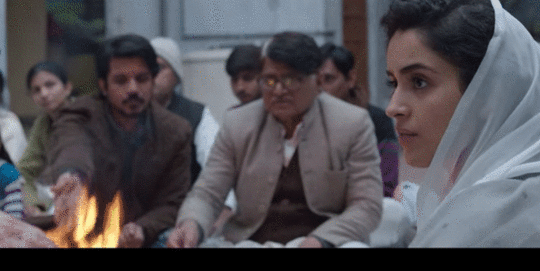Pagglait
THIS POST CONTAINS SPOILERS
Among the things that count as acting out or being crazy in Pagglait are:
eating gol gappas
drinking Pepsi
getting a job.
Man, it’s good to be a woman (in a conservative, patriarchal society).
When newly-wed Sandhya becomes a widow, she doesn’t seem to be particularly grief-struck. Some of her unflappable calm is clearly her mind working on autopilot as it grapples with the shock of her husband Astik’s sudden death. Another significant part is her refusal to perform the role that society has assigned to her. Yes, she’s a widow, but she also had an arranged marriage and barely knew her husband before he died. As the men in Astik’s family perform by rote the rituals expected of them, Sandhya grieves for the relationship she didn’t have and the husband she didn’t know. Along the way, she realises her husband had kept some rather significant secrets. For instance, Astik never told Sandhya about his ex-girlfriend and colleague, Aakanksha, whose photo he’d kept tucked among his papers. Neither had Astik shared that he had made named Sandhya as the sole nominee of his life insurance — a detail that in a flash turns Sandhya from an awkward liability to a coveted asset.
Most people would expect the title Pagglait to refer to the madness of a grieving woman acting out, but Sandhya’s actions are more socially awkward than provocative. By the end of the film, what really seems crazy is the conservatism that holds a certain section of society together. The craziness of serving tea in a “special” cup to the Muslim houseguest; of looking to marry off a widow days after her husband’s death because that is supposedly considerate behaviour; of forcing men to live secret lives. Pagglait is keenly aware of how traditions and social practices straitjacket people across genders. It’s also intent upon keeping the focus upon those who have been sidelined by Hindu tradition in particular: the women. For decades, we’ve seen Hindi cinema take stories that would have been better served by a female protagonist and have them told by heroes who occupy the spotlight just by virtue of being biological males. In Pagglait, the exact opposite happens. A man has died and the positions of power are all occupied by men; but the ones who push the story forward and claim agency are the women.
Although initially the death rituals seem senseless (especially because we’re seeing them from the perspective of Astik’s brother Alok, who doesn’t understand why Astik’s death has to mean Alok having to give up everything from decent food to his bed), the stories and symbolism of the rites gain an emotional weight as the 13 days of mourning unfold. Even though women aren’t allowed to participate in these rituals traditionally, the rites end up resonating with Sandhya. Which is why it feels like a proper triumph when on the last day, Sandhya changes a tradition to make it more inclusive. Raghubir Yadav is so good as the odious patriarch and it is particularly satisfying to have Sandhya use his exact words (used earlier in a different context) to make a progressive point. With her words, Sandhya effectively displaces the patriarch and using this ritual, she publicly acknowledges the fact that Nazia is part of her family and community.

One of the loveliest (and least credible) parts of Pagglait is the friendship that Sandhya builds with Aakanksha. Sure, it takes some serious suspension of disbelief, but it’s so nice to see the two women reach out to one another instead of lashing out in a futile attempt to be territorial over the memory of a man. The names of the two women also seem to be carefully chosen. Sandhya, or evening, marks the last period of Astik’s life. Aakanksha, true to her name, embodies all that was possibly aspirational for Astik. Aakanksha is urbane; lives alone in an apartment that’s diametrically opposite to the crumbling structure that is Astik’s family home (with its Indian style loo and strictly conservative codes of conduct); is a successful professional; and has her own car (an obvious metaphor for social mobility).

Through Aakanksha, Sandhya is able to escape the stifling atmosphere at her in-laws’ home, where everyone is hunched under the weight of upholding tradition and hiding their anxieties (or Patiala pegs). Aakanksha’s memories of Astik also help Sandhya decode the little that she has of her husband, like the cupboard full of blue, formal shirts for instance. Sandhya may not have been in love with Astik when he died, but because of Aakanksha, she finally falls in love with her husband — after their relationship is irrevocably over. When Sandhya finally heads out into the big bad world, it feels as though a little bit of Astik is by her side because of Aakanksha’s friendship and his laptop tucked into her handbag. (Three cheers for capitalism! The human is literally objectified into a product, which is supposed to leave us feeling the warm fuzzies. And we do. Because you’ve got to admit that the laptop you’re working on right now is probably your most intimate companion and offers access to most of what is important to you as a person.)
When Aakanksha becomes friends with Sandhya, she opens Sandhya’s eyes to a different world — one in which a woman holds down a job and lives independently (but isn’t necessarily independent enough to oppose her parents and marry the man she loves). So it’s interesting that Sandhya says her homemaker mother is the one who makes Sandhya realise she can get a job and fend for herself. It’s also a nice touch for Sandhya to become a pillar of support for her in-laws. Through Sandhya’s relationship with her bestie Nazia as well as Astik’s mother, father and grandma, Pagglait imagines a new kind of conservative family and a different sort of family of choice.
Deepanjana Pal's Blog
- Deepanjana Pal's profile
- 34 followers



